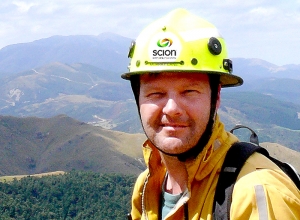Search

 Ashburton College alumnus Grant Pearce observes fire and all its erratic behaviours in his role as a fire scientist. Photo supplied.As bushfires rage across the Tasman, New Zealand fire scientist Grant Pearce sees more than just the damage they are doing.
Ashburton College alumnus Grant Pearce observes fire and all its erratic behaviours in his role as a fire scientist. Photo supplied.As bushfires rage across the Tasman, New Zealand fire scientist Grant Pearce sees more than just the damage they are doing.
The Ashburton College alumnus researches the factors leading up to such blazes, as well as the dynamics caused by them once they are under way.
Based in Christchurch as a member of Scion’s rural fire research group, Pearce was the go-to expert this week for the Science Media Centre.
Pearce may well be a scientist, but he is more likely to be donning a jacket with reflectors than a white coat.
In fact, he gets paid to do what would be an arsonist’s dream, that is light fires and then watch them burn.
He told the Guardian these fire experiments occur on small blocks of land, after gaining permission from the owner, for example a farmer who wants to burn off an area.
He is also involved in training and teaching firefighters about fire behaviour, and has been to Australia and North America to support fire operations and fire experiments.
He said he had never quite known what sort of career he might get into after studying environmental science at university, but had never dreamed of going into fire research.
After growing up in Ashburton and leaving Ashburton College in 1984, Pearce attended the University of Otago, completing a Master of Science degree in Physical Geography.
It had turned out to be not only an exciting career choice, but a rewarding one as well.
“It’s rewarding in terms of contributing to public safety and protecting firefighters,” he said.
His most recent brief has been using his experience and knowledge to take a look into the menacing heart of the Australian fires.
For the Science Media Centre gathering expert information for distribution to journalists, he said the fires across the Tasman were spreading erratically and rapidly, their intensity producing towering pyrocumulus smoke columns which extended many kilometres into the atmosphere.
“The fires interact with the upper atmosphere, creating their own weather and often over-riding the other factors of terrain and surface winds that would normally drive the behaviour of smaller fires.
Rising rapidly due to high-intensity burning, these convection columns can even form thunderstorms, producing lighting which can start more fires,” he said.
Suppression of such fires was difficult if not impossible, and it was often too unsafe to put firefighters on the ground ahead of them.
Any water, made scarce by drought, was quickly evaporated by the intense heat before it could wet the vegetation, even in in the case of large water-bombers dropping tens of thousands of litres at a time.
The fires were not a good sign for New Zealand in the face of climate change.
Research had shown that fire risk in New Zealand would likely increase, with more severe-fire-weather days in many parts of the country, as well as fire seasons starting earlier and lasting longer.
“This means the potential for not only more fires, but more larger fires exhibiting the sorts of extreme fire behaviour seen in Australia and California, and locally in the 2019 Nelson/Tasman and 2017 Port Hills wildfires,” Pearce said.
“We are already seeing an increasing trend in New Zealand in human impacts from wildfires, especially in the rural-urban interface where urban development meets rural vegetation fuels, with more homes being destroyed or damaged, and greater numbers of people being evacuated.”
While not having as severe a climate or as much expansive bush areas as Australia and America, New Zealand still had a wildfire problem in many areas, such as Marlborough and the east coast of both islands.
By Susan Sandys © The Ashburton Guardian - 16 November 2019


